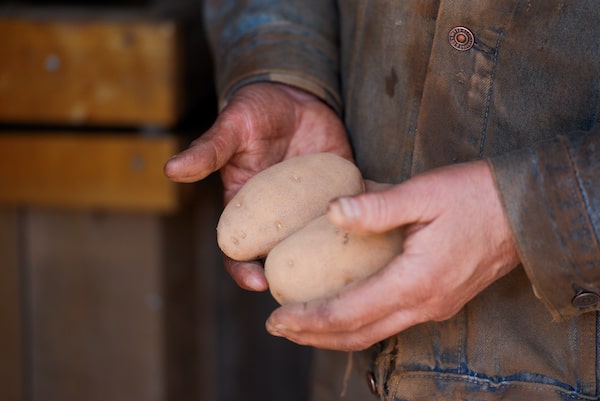
Potato farmer John Visser digs into the soil of one of his fields near Victoria by the Sea, PEI, as planters work in the background on May 19.Nathan Rochford/The Globe and Mail
The next few weeks will be an anxious time for many Maritime farmers hoping to see some rain.
Nova Scotia, New Brunswick and Prince Edward Island are experiencing one of the driest springs in recent memory. As a result, farmers planting everything from potatoes to wheat have little surface water to work with, which is vital for new seeds.
John Visser, who runs Victoria Potato Farm Inc. in Victoria, PEI, has been farming for 43 years and said it’s among the drier springs he’s seen, adding that it’s also been uncharacteristically cool on the island.
“Dry weather is good for getting crops into the ground. But at the end of the day, when they need to grow, they need heat and they need moisture,” he said.
Greg Donald, the general manager of the PEI Potato Board, said the problem is usually too much rain, not too little.
“Generally in the springtime, it’s the opposite. We’re challenged to get on the land because it’s predictable to get rain this time of year,” he said. “It’s been a long time since it’s been as dry as it is.”
Agriculture comprises a significant portion of Maritime provincial economies. PEI and New Brunswick are two of the country’s leading potato producers and have bustling grain industries. Among other crops, Nova Scotia has an established and growing fruit industry.
But a lack of rain early in the season could affect yields, farmers said.

Mr. Visser handles potatoes while working at his farm. PEI and New Brunswick are two of the country’s leading potato producers and have bustling grain industries.Nathan Rochford/The Globe and Mail
Right now, conditions are not ideal. Parts of New Brunswick and Nova Scotia experienced the driest April on record, according to a report from Environment and Climate Change Canada. “Below to much below normal” snowfall levels this winter only made things worse.
The Canadian Drought Monitor said on April 30 that much of the region is experiencing “abnormally dry” and “moderate drought” conditions. Farm associations in PEI and Nova Scotia said that was still the case as of mid-May.
Alex Cadel, a climate service specialist with CLIMAtlantic, which supplies climate-related information in the Atlantic provinces, said there’s still time for rain to prevent any yield losses this year.
“If precipitation is closer to or above normal for the rest of spring into summer, we may not see any impacts at all from the drought-like conditions,” Mr. Cadel said.
“But of course, if we do continue to get low rainfall, it could be a tougher year for folks on the agriculture side.”
Emily Lutz, the executive director of the Nova Scotia Fruit Growers’ Association, said most trees have well-established root systems to reach water deeper in the ground, helping them withstand dry weather.
However, surface water is essential for a good harvest from mature trees and for the survival of smaller, younger trees don’t have those root systems.
“It would be good to have some rain in the next couple of weeks, to give them water and to allow some of the fertilizer that’s been spread this spring to dissolve,” Ms. Lutz said.

'Dry weather is good for getting crops into the ground. But at the end of the day, when they need to grow, they need heat and they need moisture,' Mr. Visser says.Nathan Rochford/The Globe and Mail
One option to counter unpredictable weather patterns is irrigation. On PEI, the lifting of a moratorium on the drilling of high-capacity wells last year gave farmers better access to water.
But drilling isn’t a perfect solution. Mr. Donald of the PEI Potato Board said that, even with the lifting of the moratorium, only about 10 per cent of the island’s potato fields are irrigated.
“It costs a lot of money to put in an irrigation system. And in our climate, you never know if you’re going to need it or not,” he said, adding that farmers are considering the investment as weather patterns continue to change.
The Maritime provinces all have climate change-related programs for farmers – both to address emissions from farms and to prepare crops for extreme weather events. On PEI, more than $200,000 was invested when its program launched in 2021.
Many of the programs get funding through the $3.5-billion Sustainable Canadian Agricultural Partnership, with costs shared between the federal and provincial governments.
On the fields of Victoria, Mr. Visser irrigates between 15 and 18 per cent of his crop. But even with climate change-related supports, he said, “very little” is directed at solutions such as irrigation. He has paid for most of that himself.
He’s hopeful the weather will go his way once his potatoes are planted. Most crops don’t go in the ground until mid- to late May. That means there’s still time for conditions to turn around.
“The weather will warm up,” he said. “We’ll get them in the ground, then we’ll trust that the weather will start warming up and we’ll get some water.”